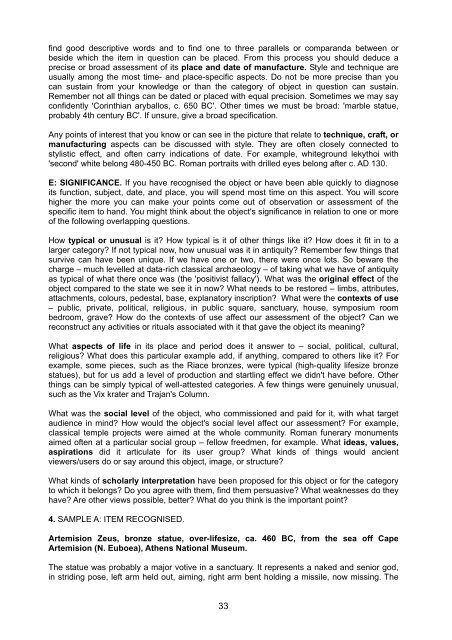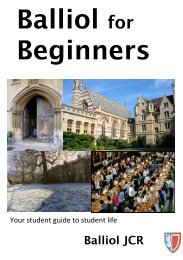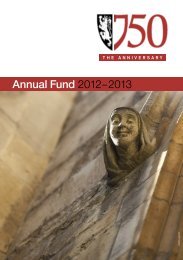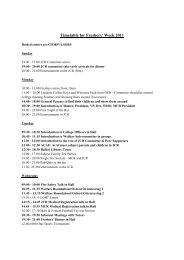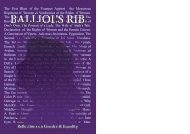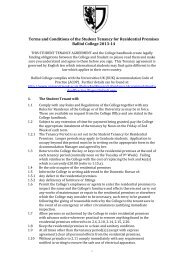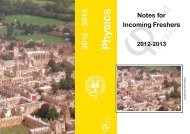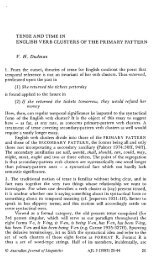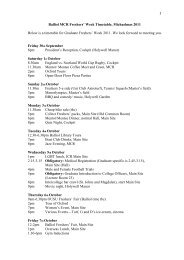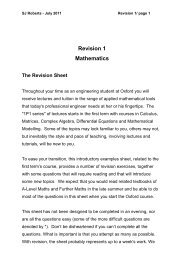CAAH Mods 2011 - Balliol College - University of Oxford
CAAH Mods 2011 - Balliol College - University of Oxford
CAAH Mods 2011 - Balliol College - University of Oxford
You also want an ePaper? Increase the reach of your titles
YUMPU automatically turns print PDFs into web optimized ePapers that Google loves.
find good descriptive words and to find one to three parallels or comparanda between or<br />
beside which the item in question can be placed. From this process you should deduce a<br />
precise or broad assessment <strong>of</strong> its place and date <strong>of</strong> manufacture. Style and technique are<br />
usually among the most time- and place-specific aspects. Do not be more precise than you<br />
can sustain from your knowledge or than the category <strong>of</strong> object in question can sustain.<br />
Remember not all things can be dated or placed with equal precision. Sometimes we may say<br />
confidently 'Corinthian aryballos, c. 650 BC'. Other times we must be broad: 'marble statue,<br />
probably 4th century BC'. If unsure, give a broad specification.<br />
Any points <strong>of</strong> interest that you know or can see in the picture that relate to technique, craft, or<br />
manufacturing aspects can be discussed with style. They are <strong>of</strong>ten closely connected to<br />
stylistic effect, and <strong>of</strong>ten carry indications <strong>of</strong> date. For example, whiteground lekythoi with<br />
'second' white belong 480-450 BC. Roman portraits with drilled eyes belong after c. AD 130.<br />
E: SIGNIFICANCE. If you have recognised the object or have been able quickly to diagnose<br />
its function, subject, date, and place, you will spend most time on this aspect. You will score<br />
higher the more you can make your points come out <strong>of</strong> observation or assessment <strong>of</strong> the<br />
specific item to hand. You might think about the object's significance in relation to one or more<br />
<strong>of</strong> the following overlapping questions.<br />
How typical or unusual is it How typical is it <strong>of</strong> other things like it How does it fit in to a<br />
larger category If not typical now, how unusual was it in antiquity Remember few things that<br />
survive can have been unique. If we have one or two, there were once lots. So beware the<br />
charge – much levelled at data-rich classical archaeology – <strong>of</strong> taking what we have <strong>of</strong> antiquity<br />
as typical <strong>of</strong> what there once was (the 'positivist fallacy'). What was the original effect <strong>of</strong> the<br />
object compared to the state we see it in now What needs to be restored – limbs, attributes,<br />
attachments, colours, pedestal, base, explanatory inscription What were the contexts <strong>of</strong> use<br />
– public, private, political, religious, in public square, sanctuary, house, symposium room<br />
bedroom, grave How do the contexts <strong>of</strong> use affect our assessment <strong>of</strong> the object Can we<br />
reconstruct any activities or rituals associated with it that gave the object its meaning<br />
What aspects <strong>of</strong> life in its place and period does it answer to – social, political, cultural,<br />
religious What does this particular example add, if anything, compared to others like it For<br />
example, some pieces, such as the Riace bronzes, were typical (high-quality lifesize bronze<br />
statues), but for us add a level <strong>of</strong> production and startling effect we didn't have before. Other<br />
things can be simply typical <strong>of</strong> well-attested categories. A few things were genuinely unusual,<br />
such as the Vix krater and Trajan's Column.<br />
What was the social level <strong>of</strong> the object, who commissioned and paid for it, with what target<br />
audience in mind How would the object's social level affect our assessment For example,<br />
classical temple projects were aimed at the whole community. Roman funerary monuments<br />
aimed <strong>of</strong>ten at a particular social group – fellow freedmen, for example. What ideas, values,<br />
aspirations did it articulate for its user group What kinds <strong>of</strong> things would ancient<br />
viewers/users do or say around this object, image, or structure<br />
What kinds <strong>of</strong> scholarly interpretation have been proposed for this object or for the category<br />
to which it belongs Do you agree with them, find them persuasive What weaknesses do they<br />
have Are other views possible, better What do you think is the important point<br />
4. SAMPLE A: ITEM RECOGNISED.<br />
Artemision Zeus, bronze statue, over-lifesize, ca. 460 BC, from the sea <strong>of</strong>f Cape<br />
Artemision (N. Euboea), Athens National Museum.<br />
The statue was probably a major votive in a sanctuary. It represents a naked and senior god,<br />
in striding pose, left arm held out, aiming, right arm bent holding a missile, now missing. The<br />
33


